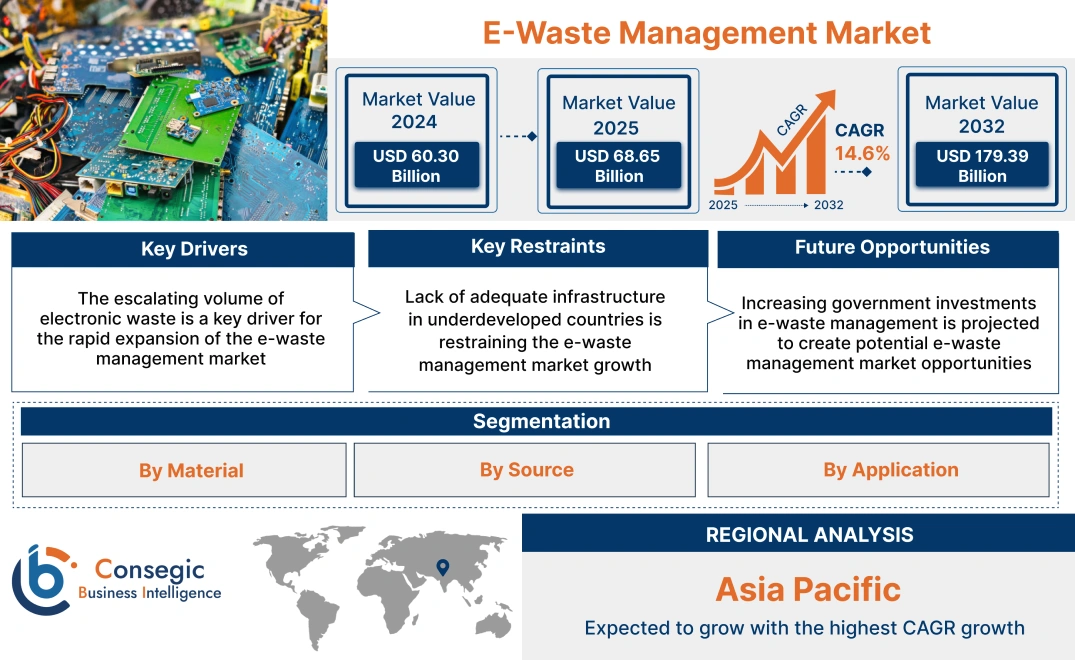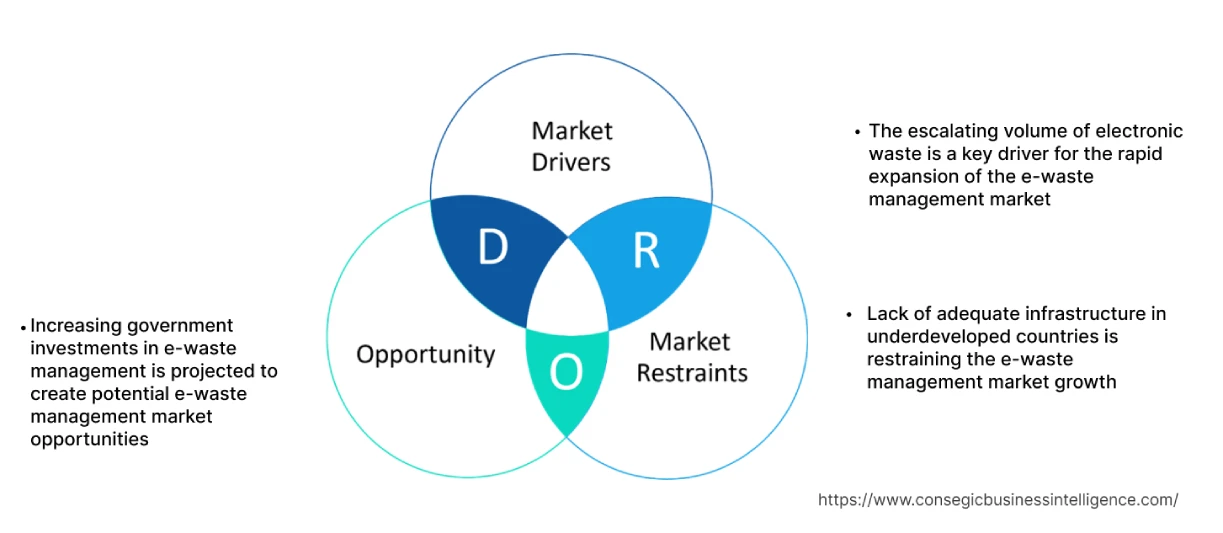- Summary
- Table Of Content
- Methodology
E-Waste Management Market Size:
E-Waste Management Market Size is estimated to reach over USD 179.39 Billion by 2032 from a value of USD 60.30 Billion in 2024 and is projected to grow by USD 68.65 Billion in 2025, growing at a CAGR of 14.6% from 2025 to 2032.
E-Waste Management Market Scope & Overview:
E-waste management refers to the responsible handling of discarded electronic devices, encompassing a wide range of items from computers and smartphones to televisions and appliances. It involves a systematic process of collection, transportation, processing, recycling or disposal of these materials to minimize their harmful impact on the environment and human health. Effective e-waste management aims to recover valuable resources while preventing the release of toxic substances often found in electronic components, thus promoting a circular economy and reducing pollution.
Key Drivers:
The escalating volume of electronic waste is a key driver for the rapid expansion of the e-waste management market
As the consumption of electronic devices is rising, the amount of discarded electronics is creating a larger pool of materials that need to be managed. This increased waste stream makes it more economically viable to invest in efficient recycling and processing technologies, further fueling e-waste management market expansion. Additionally, the growing volume of e-waste increases the environmental risks associated with improper disposal, driving the need for effective solutions to mitigate these risks, thus contributing remarkably in driving the e-waste management market size.
- For instance, according to the Global E-waste Statistics Partnership (GESP), Global e-waste generation reached a record high of 53.6 million metric tonnes in 2019. This represents a significant 21% increase in just five years, highlighting the growing challenge of managing discarded electronic products like computers and mobile phones, which contain batteries or plugs.
Thus, as per the analysis, growing volume of electronic waste is driving the e-waste management market share.
Key Restraints:
Lack of adequate infrastructure in underdeveloped countries is restraining the e-waste management market growth
Limited collection centers and transportation systems hinder the efficient gathering of e-waste, leading to improper disposal or accumulation. Insufficient recycling facilities and a lack of proper disposal methods, like sanitary landfills, result in environmental contamination and health hazards. Additionally, weak regulatory frameworks and limited enforcement capacity allow harmful informal recycling practices to thrive. The absence of sufficient infrastructure discourages investment in formal e-waste management, creating a significant obstacle that perpetuates harmful environmental practices and hinders market growth.
Thus, as per the e-waste management market analysis, the lack of adequate infrastructure in underdeveloped countries is impeding the e-waste management market growth.
Future Opportunities :
Increasing government investments in e-waste management is projected to create potential e-waste management market opportunities
Government funding supports the establishment of collection centers, recycling facilities, and proper disposal infrastructure. In addition, government investments fund research and development of innovative recycling technologies, making e-waste processing more efficient, cost-effective, and environmentally friendly, encouraging market players to adopt advanced technologies and improve their competitiveness. Moreover, government initiatives are projected to lead to the development of clear and effective regulations, such as Extended Producer Responsibility (EPR) mandates.
- For instance, in September 2023, the Technology Development Board (TDB) of India announced to support Eco Recycling Limited with ₹6 crores. Their "Recycling on Wheels Smart ER" project aims to improve e-waste management through on-site pre-processing. The process involves deploying a mobile pre-processing unit, scanning and serializing e-waste devices, shredding them, and then securely collecting the shredded material in an environmentally sound manner.
Hence, based on the analysis, increasing government investments in reducing e-waste presents significant e-waste management market opportunities.
E-Waste Management Market Segmental Analysis :
By Material:
Based on material, the market is categorized into metal, plastic, glass, and others.
Trends in the Material:
- Metals are a significant contributor to the e-waste stream and are increasingly recycled due to their inherent value and the environmental benefits associated with their recovery.
- Glass recycling, although less prevalent, is gaining traction as consumers become more aware of its environmental impact.
The metal segment accounted for the largest revenue share of 58.4% in 2024 and is also projected to register the fastest growth during the forecast period
- Metals like gold, silver, platinum, and palladium are used in various industries, including electronics, jewelry, and automotive. The rising demand for these metals, coupled with their limited availability, is driving the e-waste management market trend of the metal recovery segment.
- Additionally, advancements in recycling technologies including hydrometallurgical processes, pyrometallurgical processes, and bio-metallurgical processes enable the extraction of various metals from complex e-waste streams are making it more efficient and cost-effective to recover metals from e-waste.
- Moreover, the rising trend of recycling metals from e-waste is a sustainable way to obtain the necessary materials for manufacturing new electronic devices.
- For instance, in October 2024, MTM Critical Metals Limited has successfully used its unique Flash Joule Heating (FJH) technology to extract tin and palladium from electronic waste like printed circuit boards. The environmentally friendly process, which uses no chemicals, achieved impressive recovery rates of 86% for tin and 82% for palladium.
- Thus, as per the analysis, the aforementioned factors are driving the metal e-waste management market size.
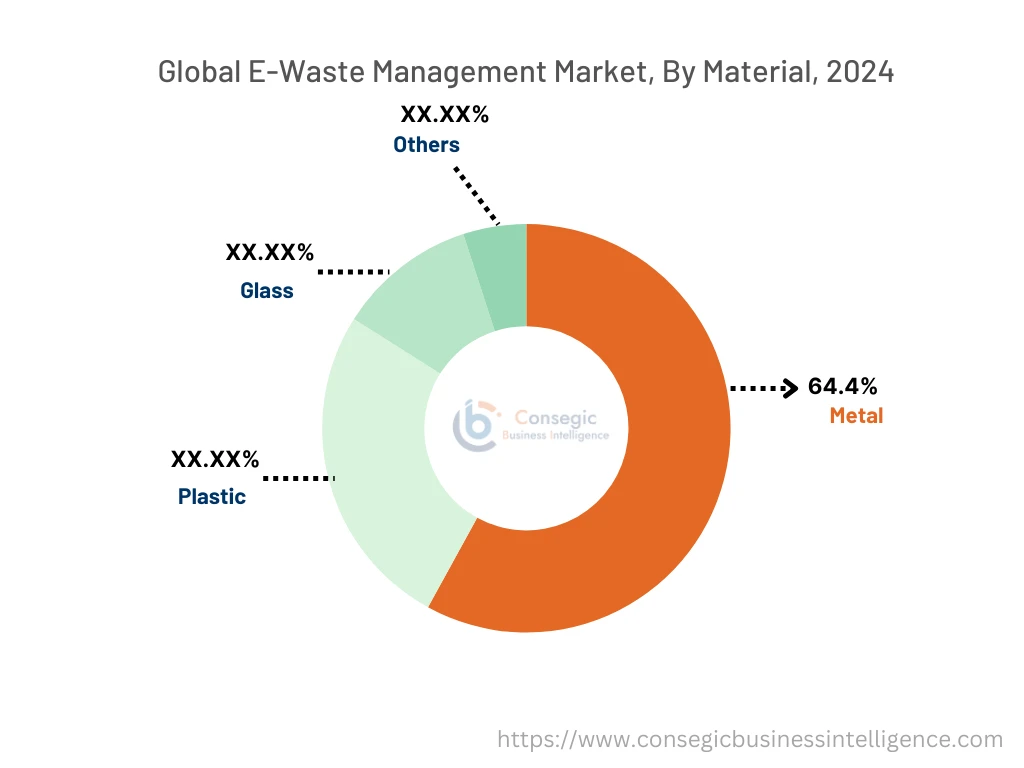
By Source:
Based on the source, the market is segmented into Industrial Electronics, Consumer Electronics, and Household Appliances.
Trends in Source:
- Discarded household appliances, such as refrigerators, washing machines, and air conditioners contain refrigerants and other hazardous materials that require careful handling.
- Consumer electronics constitute a major portion of the e-waste including smartphones, laptops, tablets, televisions, and other devices that are frequently replaced due to rapid technological advancements and changing consumer preferences.
The household appliances segment accounted for the largest revenue share in 2024
- Household appliances constitute a significant portion of the e-waste generated globally. This is due to the high rate of obsolescence and replacement of these appliances, driven by technological advancements and changing consumer preferences.
- There is a growing trend of recycling and resource recovery from household appliances, driven by the need to conserve valuable resources, reduce environmental pollution, and comply with regulations.
- Moreover, the initiation of various campaigns by companies to promote waste management is also driving the market size.
- For instance, in June 2024, BASF partnered with ERTH to launch household e-waste recycling campaign in Malaysia. This initiative aims to raise awareness about responsible e-waste disposal and provide BASF's 2,400+ employees in Malaysia with convenient access to e-waste recycling facilities. The campaign, running from July 1st to November 30th, 2024, encourages employees to properly dispose of their household e-waste, including digital and electrical items, through on-site collection points at BASF offices and sites, or by mailing their e-waste via the nearest post office.
- Consequently, these factors are collectively responsible in driving the household e-waste management market expansion.
The consumer electronics segment is expected to register the highest CAGR over the forecast period
- Consumer electronics industry, including smartphones, laptops, tablets, and TVs, have a high turnover rate. New models with improved features are constantly being released, leading to shorter lifespans for older devices.
- Modern consumer electronics are becoming increasingly complex, with a wide array of components and materials. This complexity makes recycling and material recovery more challenging, requiring specialized technologies and processes.
- Consumer electronics contain valuable precious metals such as gold, silver, and palladium. The recovery of these metals is a key driver for waste management in this segment, as it offers both economic and environmental benefits.
- Governments around the world are implementing regulations and Extended Producer Responsibility (EPR) policies to address the growing e-waste problem, further contributing to consumer e-waste management market trend.
- Therefore, the aforementioned factors are contributing notably in bolstering the consumer e-waste management market share.
By Application:
Based on the application, the market is segmented into disposal and recycle.
Trends in the Application:
- Moving away from the traditional "take, make, dispose" model, there's a growing focus on extending the lifespan of electronic devices through reuse, refurbishment, and recycling.
- The use of robotics and AI in recycling facilities is improving the sorting and processing of e-waste, leading to higher recovery rates and reduced manual labor.
Recycle accounted for the largest revenue share in the year 2024 and is also projected to witness the fastest growth in the upcoming years
- Extended Producer Responsibility (ERP) are becoming increasingly important, holding manufacturers accountable for the entire lifecycle of their products. This encourages the design of products that are easier to recycle and promotes investment in recycling infrastructure.
- Manufacturers are focusing on sustainability by using recycled materials, minimizing hazardous substances, and designing products for easier disassembly and recycling.
- New digital platforms are emerging to connect consumers with accredited e-waste disposal facilities and driving e-waste management industry demand.
- Growing trend of integration of artificial intelligence and automation in e-waste sorting and processing is enhancing efficiency and accuracy, allowing recyclers to identify valuable materials with high precision.
- Therefore, the aforementioned factors are contributing significantly in accelerating the e-waste management market demand.
Regional Analysis:
The global E-Waste Management market has been classified by region into North America, Europe, Asia-Pacific, MEA, and Latin America.
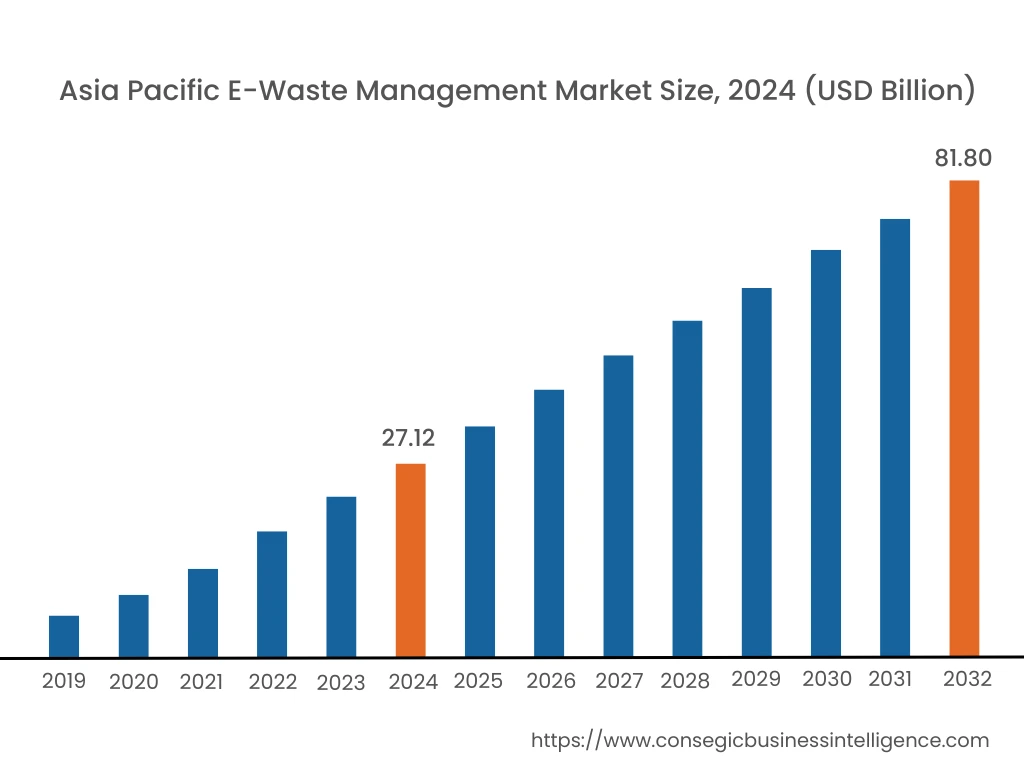
Asia Pacific region was valued at USD 27.12 Billion in 2024. Moreover, it is projected to grow by USD 30.91 Billion in 2025 and reach over USD 81.80 Billion by 2032. Out of these, China accounted for the largest revenue share of 39.7% in 2024.
The Asia Pacific e-waste management market is experiencing significant growth, driven by rapid technological advancements, increased consumption of electronic devices, and rising awareness of environmental concerns. Additionally, governments are also becoming more aware of the environmental impact of improper e-waste disposal, leading to increased demand for proper e-waste management solutions.
- For instance, in March 2023, Chairman of the HP State Pollution Control Board, launched an e-waste collection drive in Himachal Pradesh, India. A mobile van was flagged off from the HPSPCB head office to raise awareness about e-waste and the newly established e-waste kiosks. The campaign emphasized the dangers of improper e-waste disposal due to the toxic materials present in electronic devices and explained that the collected e-waste will be sent to authorized dismantlers, refurbishers, or recyclers for environmentally sound disposal. The initiative aims to promote responsible e-waste management and minimize its harmful impact on the environment and public health.
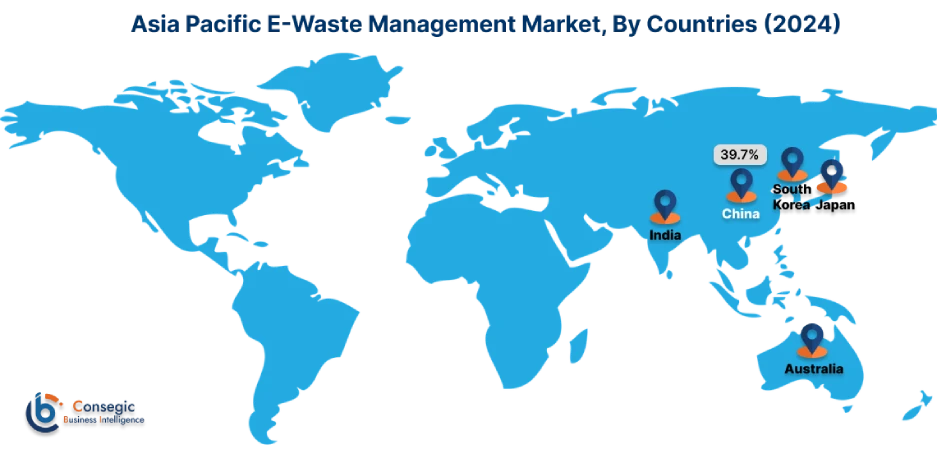
Europe was valued at USD 15.48 Billion in 2024. Moreover, it is projected to grow by USD 17.62 Billion in 2025 and reach over USD 45.91 Billion by 2032.
The European Union has implemented comprehensive legislation, such as the Waste Electrical and Electronic Equipment (WEEE) Directive, which mandates responsible e-waste collection and recycling. These regulations create a strong framework for e-waste management and drive market growth. Additionally, European consumers and businesses are generally more aware of the environmental and health risks associated with improper e-waste disposal. This awareness translates into greater demand for proper e-waste management services.
- For instance, according to the European Parliament, the amount of EEE placed on the EU market nearly doubled between 2012 and 2021, rising from 7.6 million tonnes to 13.5 million tonnes. This signifies a substantial increase in the consumption of electronics, likely driven by factors like technological advancements, affordability, and the growing reliance on electronic devices in daily life.
As per the e-waste management market analysis, the North American e-waste management market is a well-established market, driven by high consumption of electronic devices, stringent environmental regulations, and increasing awareness of the environmental impact of e-waste. The United States is the largest generator of e-waste in the region, followed by Canada and Mexico. Additionally, the Latin American e-waste management market is also facing challenges such as lack of awareness about proper e-waste disposal, inadequate infrastructure, and weak enforcement of environmental regulations. Further, the ME&A e-waste management market is a relatively small market, but it is expected to witness significant e-waste management market growth in the coming years. However, the market is also facing challenges such as lack of awareness about proper e-waste disposal, inadequate infrastructure, and weak enforcement of environmental regulations.
Top Key Players and Market Share Insights:
The market is highly competitive with major players providing e-waste management to the national and international markets. key players are adopting several strategies in research and development (R&D), product innovation, and end-user launches to hold a strong position in the market. Key players in the E-Waste Management industry include-
- Capital Environment Holdings Limited (Hong Kong)
- Eri (U.S.)
- Enviro-Hub Holdings Ltd. (Singapore)
- Sembcorp Environmental Management (Singapore)
- Tes (Japan)
- Tetronics Technologies Limited (U.K.)
- Umicore Ag & Co. Kg (Germany)
- Veolia (France)
- WM Intellectual Property Holdings, L.L.C. (U.S.)
- Sims Lifecycle Services, Inc. (U.S.)
- Boliden AB (Sweden)
Recent Industry Developments :
Partnerships & Collaborations:
- In September 2024, Aurubis AG launched its first US multi-metal recycling facility in Georgia. The plant can process over 180,000 tons of materials annually, including copper cables and circuit boards.
- In August 2024, ERI launched its first alkaline battery recycling plant in Plainfield, Indiana. The facility, located within ERI's existing e-waste recycling center, uses proprietary technology to process a significant volume of batteries annually.
E-Waste Management Market Report Insights :
| Report Attributes | Report Details |
| Study Timeline | 2018-2032 |
| Market Size in 2032 | USD 179.39 Billion |
| CAGR (2025-2032) | 14.6% |
| By Material |
|
| By Source |
|
| By Application |
|
| By Region |
|
| Key Players |
|
| North America | U.S. Canada Mexico |
| Europe | U.K. Germany France Spain Italy Russia Benelux Rest of Europe |
| APAC | China South Korea Japan India Australia ASEAN Rest of Asia-Pacific |
| Middle East and Africa | GCC Turkey South Africa Rest of MEA |
| LATAM | Brazil Argentina Chile Rest of LATAM |
| Report Coverage |
|
Key Questions Answered in the Report
How big is the E-Waste Management market? +
The E-Waste Management market size is estimated to reach over USD 179.39 Billion by 2032 from a value of USD 60.30 Billion in 2024 and is projected to grow by USD 68.65 Billion in 2025, growing at a CAGR of 14.6% from 2025 to 2032.
What specific segmentation details are covered in the e-waste management report? +
The e-waste management report includes specific segmentation details for material, source, application, and regions.
Which is the fastest segment anticipated to impact the market growth? +
In the e-waste management market, the consumer electronics is the fastest-growing segment during the forecast period.
Who are the major players in the E-Waste Management market? +
The key participants in the E-Waste Management market are Capital Environment Holdings Limited (Hong Kong), Eri (U.S.), Enviro-Hub Holdings Ltd. (Singapore), Sembcorp Environmental Management (Singapore), Tes (Japan), Tetronics Technologies Limited (U.K.), Umicore Ag & Co. Kg (Germany), Veolia (France), WM Intellectual Property Holdings, L.L.C. (U.S.), Sims Lifecycle Services, Inc. (U.S.), Boliden AB (Sweden), and Others.
